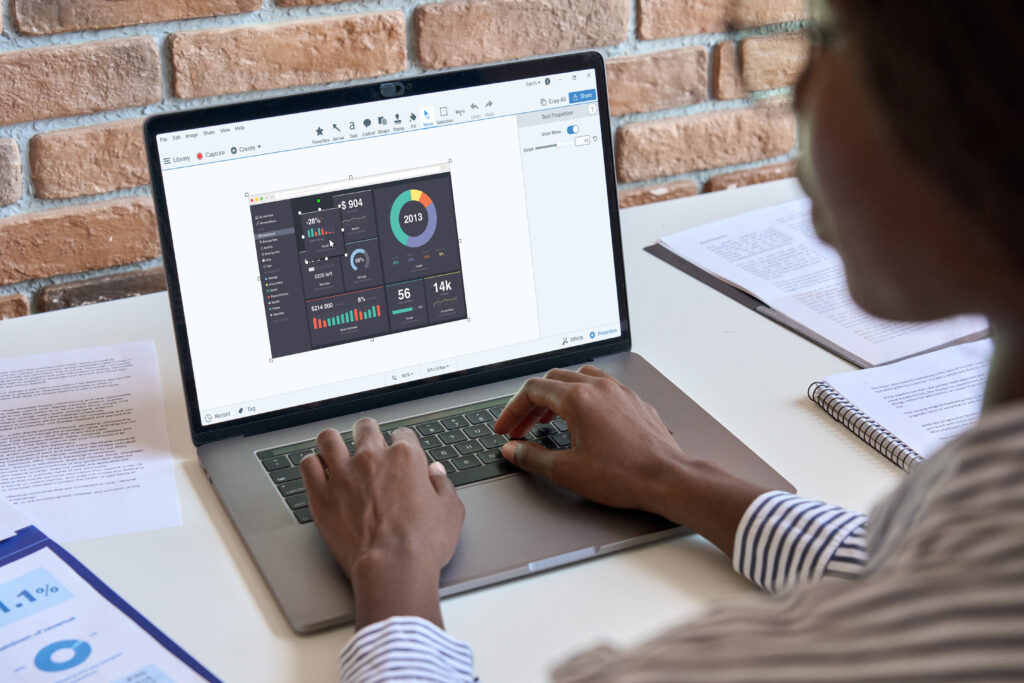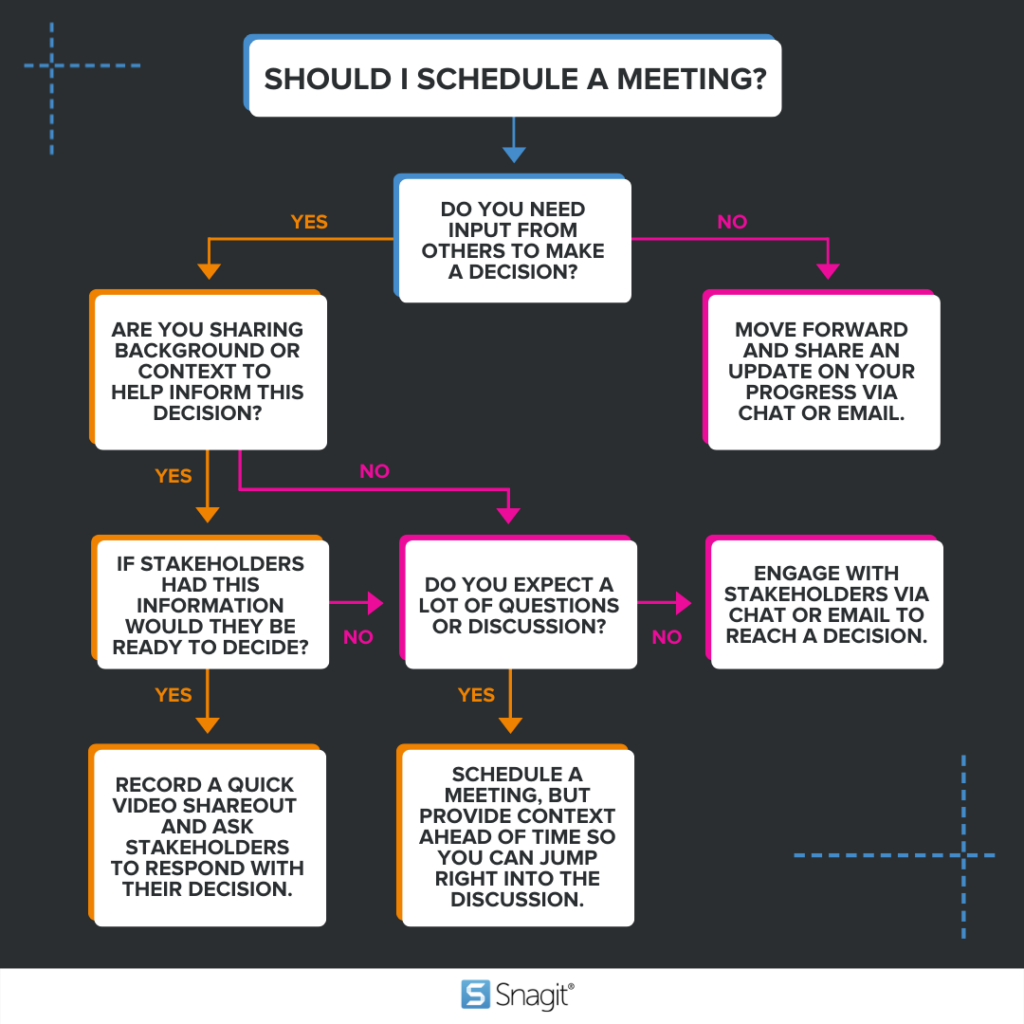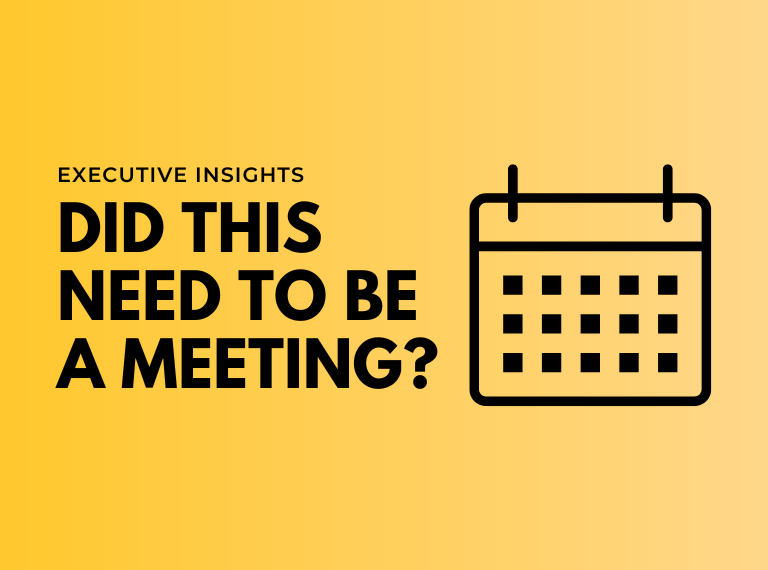In this article:
- How companies are adapting, and thriving, with a shift to remote and hybrid work
- How to create a healthier workplace culture
- Why companies like TechSmith are experimenting with asynchronous workflows
Since the early stages of the COVID-19 pandemic, six in 10 U.S. workers with jobs that can be done remotely are continuing to work from home today, according to a 2022 study by the Pew Research Center. CSC, a legal compliance consulting firm based in Wilmington, Delaware, is one of many companies opting against a return to the office since the start of the pandemic.
It wasn’t long into the remote work pivot that Mark Tarone, a senior user experience engineer for enterprise technology at CSC, noticed a screen full of blank stares during a regularly scheduled status update.
“There was no discussion, no debate, no decision that had to be made during this meeting,” Tarone said. “We would sit there for 30 minutes and you could see people zoning out.”
The solution? Inviting the project manager to create videos and screenshots that team members could view ahead of the live updates — and on their own time in 10 minutes or less. This eliminated some all-team remote meetings and began the shift to a more asynchronous work schedule.
“People are elated — it’s been a big victory,” Tarone said. A staggering 83% of the more than 9,000 global workers surveyed for Accenture’s Future of Work study, released in April, said they prefer the ability to work remotely at least part of the time.
Tarone and other executives with insights into remote work communication convened virtually in June 2022 for a thoughtful discussion on the evolving dynamics of workplace communication. The conversation was hosted by Crain’s Content Studio, the marketing storytelling division of Crain’s Detroit Business, in partnership with Michigan-based TechSmith, a global leader in screen capture and screen recording software.
During the virtual conversation, the executives agreed that productive hybrid work models require an intentional shift in a company’s overall communication strategy.
“We will continue to see a lot less focus on ‘core working hours’ and more of this ‘anytime, anyplace’ mindset, which is individually flexible and creates an environment where employees and teams feel empowered to do their best work,” said TechSmith CEO Wendy Hamilton.
Roundtable participants
Francine Dubicki
Director, New Business and Financial Service Operations, Mutual Trust Life Insurance Company
Matthew Dyer
Head of Developer Education, Netflix
Kimika Garrett
Chief People and Culture Officer, Walker-Miller Energy Services
Wendy Hamilton
CEO, TechSmith
Catherine Kosin
Managing Director, Senior Vice President, Oswald Companies
Jesse Lahey
Co-founder and Strategic Partner, Workforce Communication
Elizabeth Pierce
Senior Director, Learning Experience, Consulting, TaskUs
Mark Tarone
Senior User Experience Engineer, Enterprise Technology, CSC
Building a digital toolbox
Matthew Dyer, head of developer education for Netflix, has worked remotely since he started at the company just over a year ago.
He characterized his team’s communication best practices as being supported by a mix of synchronous and asynchronous tools.
“Most of the heavy lifting at Netflix happens in the comments section of a Google Doc,” he said. “Often, the first thing I do is browse the comments because I know that’s where all the actual dialogue has happened.”
Asynchronous workflows, like the use of Google Docs, allow employees to connect when it’s convenient for them. Alternatively, synchronous platforms require team members to log in and participate at a specific time.
“There are different communication tech stacks that you can have based on the size of your company, what your company does, what your culture is — even where your people are located,” said Elizabeth Pierce, senior director of learning experience for digital services provider TaskUs. “If you have a company of 200 people, what works for you is not going to work for a company of 2 million employees.”
Jesse Lahey, co-founder and strategic partner at Workforce Communication, is a frequent user of the voice messaging app Voxer, which allows for asynchronous phone calls.
“For a lot of us, it feels like the phone weighs 100 pounds,” Lahey said. “If I pick it up or call somebody, I might get stuck in a 30-minute conversation. But to be able to hit a button, leave a voice message and then get a response when it’s a good time for them speeds up a lot of conversations.”
Francine Dubicki, director of new business and financial service operations for Mutual Trust Life Insurance Company, said her team uses Box, a cloud-based content management and file sharing tool, to keep Mutual Trust’s global workforce connected and “on the same page” despite being in different time zones. Dubicki says she also depends regularly on Snagit to create user documents with detailed screenshots and for creating inspirational emails that feature call-out bubbles and fun graphics.
“We are big fans of utilizing those asynchronous tools as necessary and we continue to look for those collaboration opportunities, whether it’s new software or learning more about the software we already have,” Dubicki said.

Tech toolbox tips
- Google Docs: Collaborative word-based document
- Box: Cloud-based content management and file-sharing
- Snagit: Screen capture and recording tool; creates visual communication through images, GIFS, and videos
- Voxer: Voice messaging, push-to-talk communication
- Camtasia: All-in-one video editing and screen recording to create, edit and share videos
Rethinking meetings
A 2021 study by Reclaim.ai found the average professional spends over half of their workweek — 21.5 hours — in meetings. Pre-Covid, professionals spent about 14.2 hours weekly meeting. One-on-one check-ins alone increased 500% since the pandemic began.
One factor underlying the spike in virtual meetings is “the need to monitor and see people in order to feel like work is advancing,” according to the “Hybrid Workplaces” insights report from Harvard Business Review. The authors ultimately attribute this “need” to the clash between antiquated 9-to-5, in-office thinking where work is done synchronously, and an increasingly remote workforce, where work happens on each employee’s own schedule.
How many of those meetings could have been an email, a video message, or a collaboratively shared document?
“We are trying to get people to ask themselves, ‘does this need to be a meeting?’ before sending the meeting invitation,” said Catherine Kosin, managing director and senior vice president of Cleveland-based insurance firm Oswald Companies. “One way we hope to reinforce that idea is an automatic default on Outlook that requires users to include an agenda with expected meeting outcomes when sending a calendar request.”
Kosin and her team also implemented a companywide “no-meeting-Fridays” policy, primarily for internal meetings.
TechSmith took steps to reduce the amount of meetings by asking team members to prioritize asynchronous work for the month of July. Hamilton said the company tested “no meeting” days or weeks in the past, but many employees bumped their appointments to the following day.
“We’re trying to see if that ‘async-first’ focus instead helps us and our team members better evaluate when we need a meeting,” she said.
Chief People and Culture Officer at Walker-Miller Energy Services, Kimika Garrett, said she often cancels meetings that aren’t necessary.
“When I joined Walker-Miller in February, I blocked off every Friday,” Garrett said. However, some Friday meetings do make it onto her schedule on a case-by-case basis, she added.
Netflix attempted to give all employees a late summer break by initiating “slow August,” which meant cancelling recurring meetings in 2021. According to Dyer, the impact was uneven.
“Because other people like developers were heads down, our folks in corporate engineering who were doing the tooling support had more work to do,” Dyer explained. “This might not be a thing you can necessarily mandate at a company level.”

Communicate, communicate, communicate
While clear communication is the bedrock of building a fulfilling workplace culture, these experts believe using both synchronous and asynchronous tools is critical in accommodating varying communication preferences.
“We have six generations in the workforce today, and each of them receives data in a different way,” Kosin said. “We can’t just make everything a video and we can’t make everything an email.”
If leaders at Oswald Companies plan a town hall webcast to communicate to employees, for example, they might follow that up with a newsletter, Kosin explained, “so that the person who doesn’t enjoy listening or being on camera can reference that information later.”
Pierce said she believes in delivering information three times, and in a different way each time. An all-team meeting could be followed up by a summary email and then a short video, for instance.
“We have different generations out in the workforce, and we also have different learning styles,” Lahey said. “Some people are readers; some people need things visually and some are auditory learners.”
Garrett also highlighted the power of asynchronous tools to help improve communication for her entire team — especially for those who work off-site.
“I have field staff who are unable to attend lunch-and-learns or who are unable to be at a computer, so I need to make sure that I’m tailoring, crafting and delivering communication in a way that is effective,” Garrett said.
Experimenting with different communication techniques and tools, Pierce added, is a crucial part of building a workplace communication strategy. High rates of attrition or sparsely attended company events – virtual or otherwise – are often signs of a communication breakdown, she said.
Work-in-progress
People are now accustomed to working from home and not battling the five-day commute. Increased flexibility is a competitive advantage in today’s talent war, with remote and hybrid work opportunities expanding globally.
At Walker-Miller, Garrett is broadening her team’s search for certain positions outside of Walker-Miller’s primary site locations. She said she’s also focused on a wider talent-pool search that goes beyond diversity in gender and race and includes veterans and retirees.
From an HR perspective, Garrett is focused on shifting existing ideas on hiring practices and getting creative with finding talent.
“We are already seeing how big of an impact the ability to communicate and collaborate without being face-to-face — or without even being available at the same time — has on talent recruitment and retention and frankly, productivity,” Dubicki explained. “Working practices are evolving, and if we want to continue to build our teams, so must our thinking.”





